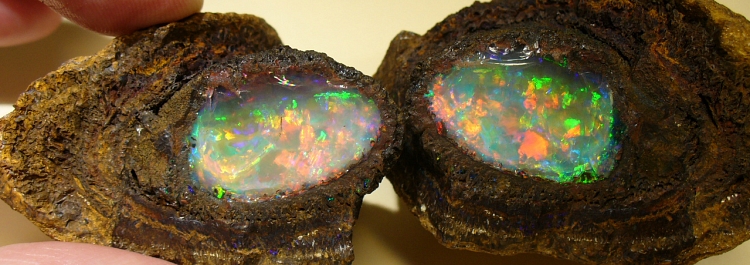Opalised Fossils and Specimens
Opal is a spectacular gemstone. It is also a dazzling key to Australia’s mysterious past, because buried in the Australian opal fields are fossils of dinosaurs and other strange creatures that lived 110 million years ago, in Early Cretaceous times.
These fossils are literally gems: teeth, bones, shells and pinecones which have turned to solid opal. Australia is the only country where opalised animal fossils are found.
Opalised fossils are rare and precious; even more so because in Australia, it is rare to find fossils of any kind from the time of the dinosaurs.
During Cretaceous times a shallow inland sea called the Eromanga Sea covered nearly one-third of Australia. Streams and rivers fed into saltwater estuaries, and evergreen forests blanketed the floodplains.
While pterosaurs soared overhead, the waters of the Eromanga Sea teemed with fish, invertebrates and marine reptiles such as plesiosaurs, pliosaurs and ichthyosaurs.
Some opal fields, such as White Cliffs and Coober Pedy, mainly produce fossils of marine (saltwater) plants and animals. At Lightning Ridge, most opalised fossils are from land-living or freshwater animals and plants. Opalised snails and mussel shells are found on most Australian opal fields, because snails and mussels live in both marine and freshwater environments.
Every single opalised fossil found is considered a national treasure. The National Opal collection is a treasure trove of rare opalised fossils and opal specimens.
Opalised Belemnites
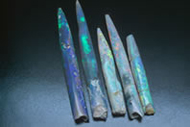 Belemnites probably looked much like a modern squid. These specimens are the most commonly preserved part of the animal. It is the reduced shell, which has become an internal support, like the pen of a squid, or a cuttlefish skeleton.
Belemnites probably looked much like a modern squid. These specimens are the most commonly preserved part of the animal. It is the reduced shell, which has become an internal support, like the pen of a squid, or a cuttlefish skeleton.
Shells
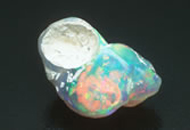 These black opal gastropods found at Lightning Ridge once lived in an estuarine environment 110 million years ago.
These black opal gastropods found at Lightning Ridge once lived in an estuarine environment 110 million years ago.
Opalised Vertebra
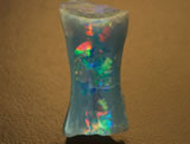 Juvenile dinosaur vertebra with gem quality opal from Lightning Ridge.
Juvenile dinosaur vertebra with gem quality opal from Lightning Ridge.
Opal Pineapple
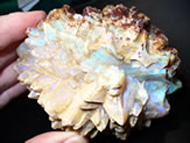 This crystal-like shape is known as an Opal Pineapple. In fact they are neither crystals nor pineapples. Opal is an amorphous mineral, meaning they have no crystal form. Opal pineapples are Pseudomorphs, which occur when one mineral replaces another making a cast of the original mineral. Opal has replaced the original mineral Ikaite, which only crystallises in near freezing conditions. This suggests that these pineapples had their beginnings in an ice age.
This crystal-like shape is known as an Opal Pineapple. In fact they are neither crystals nor pineapples. Opal is an amorphous mineral, meaning they have no crystal form. Opal pineapples are Pseudomorphs, which occur when one mineral replaces another making a cast of the original mineral. Opal has replaced the original mineral Ikaite, which only crystallises in near freezing conditions. This suggests that these pineapples had their beginnings in an ice age.
Yowah Nuts
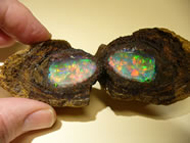 These occur in Southern Queensland where opal infills the central cavity in ironstone concretions. Yowah refers to the small mining town in which they are found, although similar "nuts" are also mined in nearby Koroit.
These occur in Southern Queensland where opal infills the central cavity in ironstone concretions. Yowah refers to the small mining town in which they are found, although similar "nuts" are also mined in nearby Koroit.




